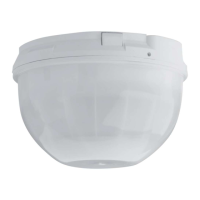DS9360 Installation Guide © 2011 Bosch Security Systems, Inc. Page 3
7.2 PIR Sensitivity Selection Pins
For selection, place the plug across the pins marked I for
Intermediate mode or H for High mode.
• Intermediate Sensitivity (I): Tolerates environment extremes
on this setting, but requires the largest amount of intruder
motion to achieve an alarm.
• High Sensitivity (H): The recommended setting for most
installations. Use in locations where an intruder is expected to
cover only a small portion of the protected area. Tolerates
normal environments on this setting. The detector is shipped
in High Sensitivity mode.
7.3 Microwave Adjustment
Note: It is important to wait 1 minute after removing/replacing the
cover so the microwave portion of the detector can settle,
and to wait at least 5 seconds between the following walk
testing procedures.
• The tri-color LED should be OFF before walk
testing.
• Walk test across the pattern at the intended
coverage’s farthest end. Start walking from
outside the intended protection area and
observe the tri-color LED. The edge of the
microwave pattern is determined by the first 3 color, microwave
activation of the LED (or the first red activation if the green PIR
LED activates first).
• If adequate range can not be reached, increase the Microwave
Range Adjust slightly. Continue walk testing (waiting 1 minute
after removing/replacing the cover) and adjusting the range
until the farthest edge of desired coverage has been accurately
placed.
Do not adjust the microwave range higher than required.
Doing so will enable the detector to catch movement outside
of the intended coverage pattern.
• Walk test the unit from all directions to determine all the
detection pattern boundaries.
8.0 Supervision Features
The supervision features function as follows:
• PIR/Microwave: The complete circuit operation of these
subsystems is checked approximately every 6 hours. If the PIR
or microwave subsystem fails, the red LED will flash 4 times
per cycle and the unit should be replaced.
• Default: The detector will default to PIR technology protection if
the microwave subsystem fails.
9.0 Other Information
9.1 Anti-Vandal Screws for EN50131 Applications
• After the cover has been installed and twisted into place, the
entire assembly can be secured together using the supplied
anti-vandal screws. The anit-vandal screws are required for
EN50131 applications. Refer to the Top View of Enclosure
figure on page 2 for the location of the screw holes.
9.2 Maintenance
At least once a year, the range and coverage should be verified. To
ensure continual daily operation, the end user should be instructed
to walk through the far end of the coverage pattern. This ensures an
alarm output prior to arming the system.
9.3 Reading Bosch Security Systems, Inc. Product Date
Codes
For Product Date Code information, refer to the Bosch Security
Systems, Inc. Web site at:
http://www.boschsecurity.com/datecodes/.
MIN
MAX
Microwave
Adjustment
10.0 Optical Module Masking
• Peel-off masks are provided with the unit for each segment of
the optical module to allow for customized coverage, or to
block out areas of objects that may cause thermal
disturbances. The mask is self-adhesive and pre-cut in the
shape of the optical module.
• The location of the zone to be masked depends on the
position of the detector. Therefore, determine the mirror
surface to be masked before removing the mirror from the
detector.
• To block out a particular zone or group of zones, peel off a
section of the mask that corresponds to the appropriate zone,
and stick it on the mirror segment. Before attempting any
masking, be sure the chosen mirror surface is the correct one.
NOTE: When attempting to remove any masking, many
adhesives will either destroy the mirror surface or leave
enough residue behind to reduce coverage performance.
AR8-13
D
432143125
A
BP
C
E
F
G
H
I
J
N
O
K
L
M
A
B
C
D
E
F
G
H
I
J
K
L
M
N
O
P
TOP VIEW
M-4
M-3 M-2 M-1 E-1 E-2 E-3
E-4
5
SIDE VIEW
• When replacing the mirror, make sure it is facing the same
direction as before it was removed.
NOTE: Avoid soiling or leaving fingerprints on the mirror surfaces.
Should they become soiled or otherwise marked, they can
be cleaned using a soft, clean cloth and any commonly
available mild window cleaner.

